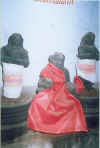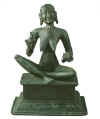Karaikkal Ammaiyar - Shaiva Saint
Karaikkal
Ammaiyar, a woman named Punithavathi, belonging to the vaishya (merchant)
community, lived in Karaikal sometime in the sixth century A.D. 
Followers of Shaivaism pay homage to a group of sixty-three great devotees "slaves of the lord" referred to as "Nayanmars". These saints who lived from the sixth through the tenth century, were part of the Bhakthi movement, characterised by intense devotion to an single God, over and above the performance of rituals. Punithavathi's exceptional devotion to Shiva earned her a place among the sixty-three saints (Nayanmars) under the name Karaikkal Ammaiyar.
Karaikkal Ammaiyar produced 2 works - Arputha Tiruvantadi and Tiru erattai mani malai.
Hagiography: The young and beautiful lady by name Punitavatiyar, daughter of Dharmadathan (father) and Dhanalakshmi ammal (mother) married Paramadathan a wealthy merchant.
One day Dharamadathan sent two mangoes to his house. Punithavathy kept them safely so that she could serve her husband with them at meal-time. In the meantime, a Siva Yogi appeared before her. He was hungry and completely exhausted. Punithavathy worshipped him and offered one of the mangoes to him as Bhiksha, as she had nothing else to offer. At midday Dharamadathan came to the house. The wife served him with one mango. He liked it, and asked for the other. She was upset that she had given it away. She appealed to the Lord for help and mysteriously a mango fell on her palms. She gave it her husband who found it exceptionally tasty. He asked her as to where she got it, as he was sure it was not the mango he had sent. Punithavathy told him the whole truth. Dharamadathan, however, would not believe this and challenged her to produce another. She prayed again and another mango appeared on her palm. She gave it to him. But, at once it disappeared from his hand. He was astounded. He understood the greatness of his wife and felt it a great sin to live with her as her husband. On the pretext of going to a foreign country for trade, he sailed with a ship load of goods. On return, he established himself in a big city in the Pandyan kingdom. He married another vaisya girl and named the daughter by her Punithavathy, in memory of his first wife.
The first Punithavathiyar’s relatives coming to know of her husband’s whereabouts, took her there in a palanquin. Paramadattan on hearing that Punithavathy was coming to him, went with his second wife and child and fell at her feet. When the people demanded an explanation, he revealed that he regarded her, not as his wife, but as a Goddess.
Punithavathy understanding his mental condition, prayed to the Lord: ‘In that case, Oh Lord, deprive me of the present physical charm and let me have a demoniacal form.’ Her prayer was immediately granted and her charming youthful body was transformed into a skeleton.
Then she went on a pilgrimage to the holy Kailasa. Feeling that it would be a great sin to place her foot on the sacred ground, made the last part of the journey on her head. To the surprised Parvathy, Shiva explained Ammaiyar’s greatness welcomed her with extreme love and granted a boon.
She fell at His Feet, and prayed: ‘Oh Lord of Mercy, give me sincere, pure, unalloyed, eternal and overflowing devotion unto You. I want no more birth. If, however, I have to take birth here, grant me that I should never forget You. Whenever You dance, I must be at Your feet singing Your praise. This is my only wish’.
Lord Siva granted the boon and asked her to
proceed to Tiruvalangadu to witness His dance. She went there and the the Lord danced for her delight.
Thiruvalankadu is known as Rathnasabai,
one of the famous Ainthu ambalangal (the five temples) where danced as Nataraja.
She spent the rest of her life singing in praise of Lord Siva. 
Perhaps her own description of herself as the "ghoul of Karaikkal" in the signature verse of some of her poems may be responsible for the often fearsome imagery portrayed by artists.
Saint Andal, a devotee of the God Vishnu, who lived in southern India around the year 800, and Karaikkal Ammaiyar are two of the few women saints honored with their images in temples.
The ground is damp
with liquid marrow--
Skeletal ghouls with sunken eyes
jostle and elbow--
looking furtively around them
extinguishing the fires
with gleeful hearts
they eat half-burned corpses--
There, in that menacing forest
holding fire in his hand
dances our beautiful lord.
Idol: Karikkal Ammaiyar - worshiped in
Shiva temples
Amoung the statues of 63 Nayanars of Shaivaism in Shiva temples, regularly
worshiped
Bronze: Seated Saint Karaikkal Ammaiyar
India, state of Tamil Nadu, Chola period, 12th century. Bronze. Lent by the
Metropolitan Museum of Art,
Purchase, Edward J. Gallagher, Jr. Bequest in memory
of his father, Edward Joseph Gallagher, his mother, Ann Hay Gallagher, and his
son, Edward Joseph Gallagher III, 1982
www.metmuseum.org